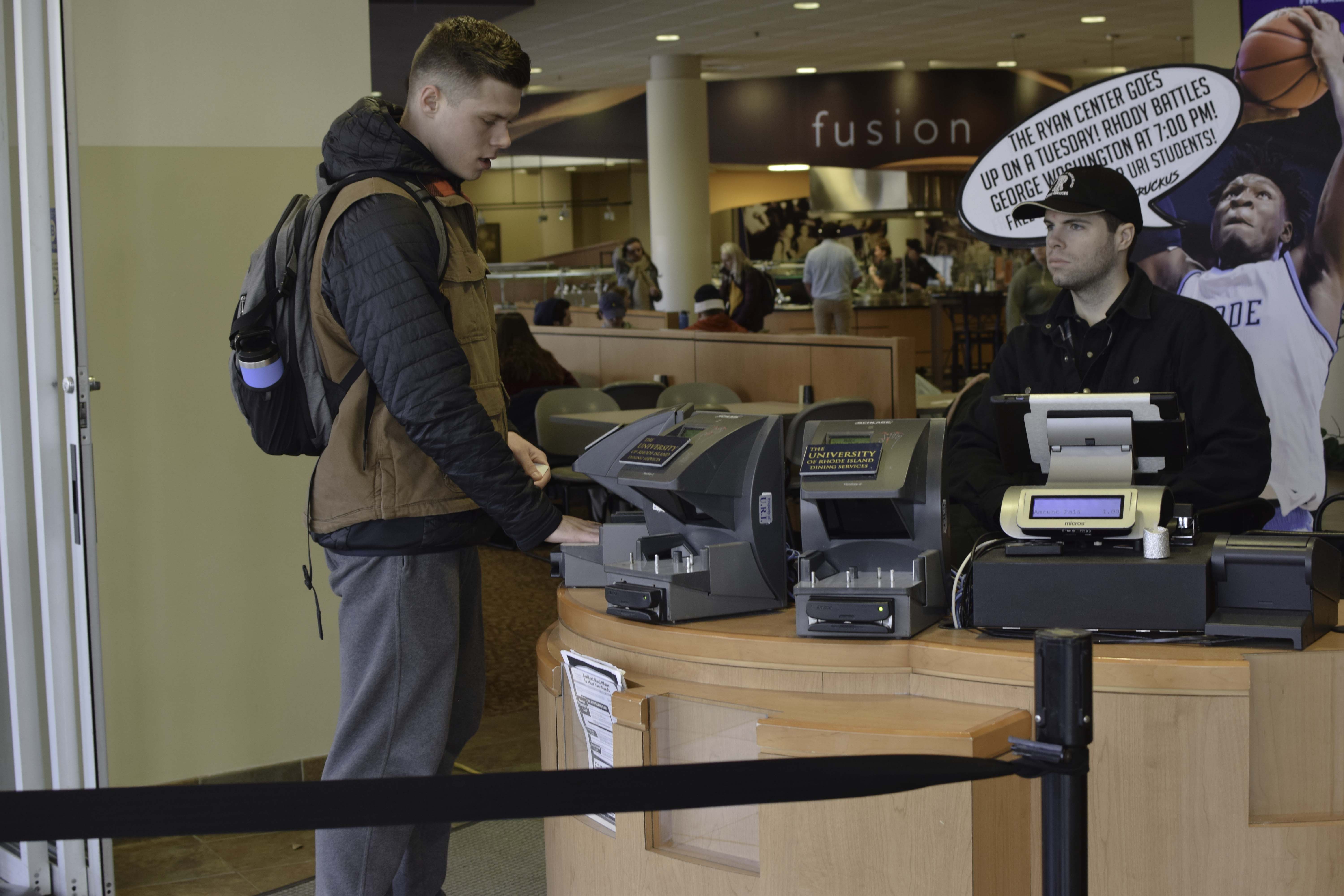To access the dining hall, students must scan their hands, leading to questions about the safety of accessing residence halls. Photo by Joseph Lachance.
At the University of Rhode Island, some students have wondered why there
When you enter your residence hall, all you have to do is either swipe your card or walk in behind someone who opened the door. When you enter a dining hall, however, you have to swipe in and go through the process of getting your hand scanned.
At many colleges and universities, students are required to swipe into their dorm through a welcome desk as well as sign in all their guests. At URI, it is a much easier process for students to enter the dorm buildings, as well as have people stay over for periods of time.
Housing and Residential Life (HRL) is primarily in charge of safety within the dorms, and Dining Services have the majority of control over dining locations. The departments work closely with Public Safety to ensure the efforts are up to par.
“Our officers are on patrol 24-7,” Chief of Police and Director of Public Safety Stephen Baker said. “We try to be in the locations where the students are. We spend more time in the dining halls now and we have the substation down in Barlow Circle. We try to have a presence right in the dorm area.”
Baker does believe there are ways in which safety can be bettered at URI. According to Baker, Public Safety is often updating the cameras on campus in their domain and HRL continues to add more in the dorms independently.
Baker did note that access times are an area which should be improved.
“As it stands now, people from different dorms have access to the other dorms until a certain hour at night, which is a little different from other locations,” Baker said. “It’s fine as long as everybody that goes in is logged in some ways so that if something does occur we know who’s in the building, but we always have the potential issue of doors being propped open or holding doors for people who they think belong there.”
While Public Safety works closely with HRL and Dining Services, Dining Services is in charge of their own entry processes. This means Dining Services itself is the department that mandates the hand scanners to enter.
According to the Manager of Mainfare Dining Hall, Tara Connors, the main purpose of the hand scanners is to ensure students are not sharing meal plans.
“We want to be fair to students that are purchasing the meal plans,” Connors said. “A lot of the times the parents are purchasing them as well, and we want to make sure that the money is being spent as it should be spent.”
Without the scanners, students could get away with using the unlimited dining hall swipes on every meal plan to their advantage, as there is no time limit in between swipes. The entry process ensures students cannot share a meal plan with friends.
Occasionally, if there is a crime on campus, the campus police will contact the dining halls to see if there is a hand scan from the individual in question, according to Connors. If their hand was scanned, it shows if a person was at the dining hall at the time they said they were.
HRL’s efforts to prioritize safety within dorms is different than Dining Services efforts, but this doesn’t necessarily mean the dorms on campus are unsafe.
Frankie Minor, director of housing and residential life, emphasized that students feeling safe is of the utmost importance to their department.
“Student safety and security is our first priority,” Minor said. “We want students to enjoy themselves, feel comfortable, form great friendships, find support on their hall’s for academic success, but if we can’t get any of that, minimally we want them to feel safe and secure. Anything that may challenge that we take very, very seriously.”
What sets dining hall and dorm security apart is the buildings they are located in. “Part of it is modern technology that has allowed us to have alternative points of entry,” Minor said.
Amanda Downey, associate director of Residential Education, agreed that it is often more difficult to have every student go to one door to swipe in at a welcome desk or access the building through only one entrance.
“We want to give our students a certain amount of freedom and privacy, and we want to balance that with safety.” Downey said. “If I go up to a door, I expect the door to open. So if we were to funnel to a front door, all those other doors would have to be locked so that you couldn’t access them. That would become incredibly frustrating.”
The security measures differ between dining halls and dorms simply due to their designs and purposes, according to each department respectively. Dining Services works to ensure students are not using the same meal plan, and this work requires the hand scanners, according to Connors. Most dorms do not need the same preventative measures as the dining halls, which allows their access points and entrance processes to be much easier for students to utilize, according to housing.

